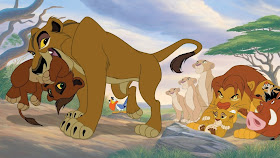 The Oscars in March 2002 were the first to have an Academy Award for feature-length animation. In February, on the 3rd to be precise, I had a little prediction after seeing a film newly released in UK cinemas:
The Oscars in March 2002 were the first to have an Academy Award for feature-length animation. In February, on the 3rd to be precise, I had a little prediction after seeing a film newly released in UK cinemas:‘Watched the highly entertaining future animation Oscar winner (I expect!) Monsters Inc. – A great premise, great characters and some really funny gags made for a very enjoyable viewing. Boo is an unbelievably sweet little kid, I thought the characters’ names were clever and, while things still look much like plastic, CG is getting better and better, especially that Fiz-T technology. My only question would be – if they know kids aren’t really toxic, why all the security? If they are, why no effect?’
In the event, it was not to be a win for Pixar – indeed, Monsters Inc. was one of only two Pixar films not to win the award, along with Cars. In this case, I think the decision was a bad one: Shrek spawned a successful and enjoyable franchise, but that first film was not a great accomplishment – and I would have preferred to see this film win.
Monsters Inc. is another clever take on an old concept regarding childhood. Those scary monsters under the bed and lurking in the closets and cupboards of the world are real – and part of an industry. They harvest the screams of children to power their society. It all works nicely until one of the best ‘scarers’, James Sullivan (I mentioned that I thought the names were clever – and what I thought was clever about them was that they were so ordinary, rather than being fantasy monster names) accidentally brings a little girl back into his world with him. Believing the child to be toxic and dangerous, he and his best friend Mike have to work out what to do with the strange, giggling little creature.
The question about toxicity has been raised since by others: why spread a false rumour that children are toxic? The best answer I’ve seen is that it’s a psychological trick: the workers are told the kids are dangerous to motivate them to do their jobs and get out quickly. That’ll do – it’s only a minor issue in any case.
Monsters Inc. has dated well, probably better than the first Toy Story or A Bug’s Life – although neither are exactly unpleasant to watch. It’s still extremely impressive, how much work has gone into each frame, and those Fiz-T hair effects remain impressively fluid. But of course, the main thing that makes Pixar the success it is would be those strong concepts, great characters and heartwarming developments. That’s why Monsters Inc. was a great success. And that’s why the prospect of a prequel coming out in 2013 is really quite an interesting one…























